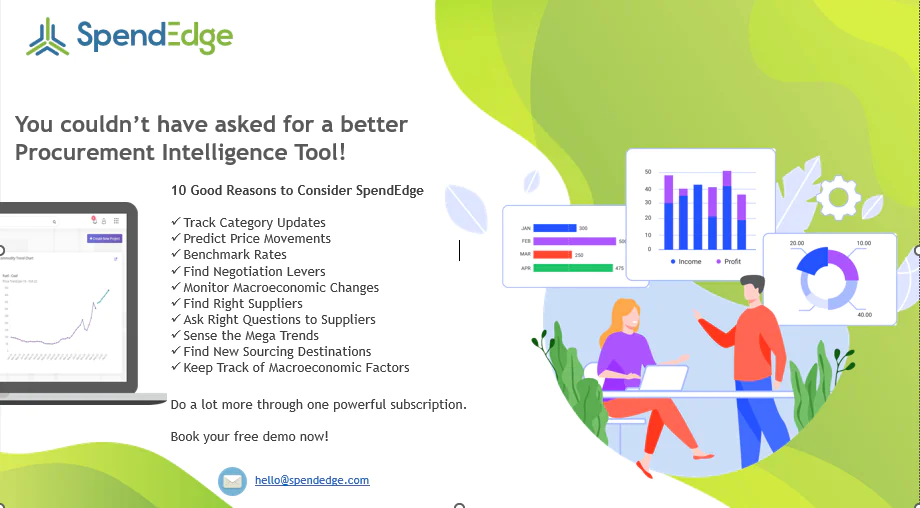Most companies often focus their efforts on direct spend categories and place a low level of importance on indirect spend. However, indirect spend can make up a high proportion of third-party spend in most companies. Often overlooked, indirect spend management is gaining attention due to its ability to derive more value from their supplier spend and further increase savings. Indirect spend management is not so straightforward and easy. Managing IT, MRO, logistics, utility, and travel requires a different kind of skillset and expertise from the procurement teams. If procurement teams are able to manage and take control over the indirect spend effectively, they can create more savings opportunities. So what are the barriers procurement professionals need to overcome to unlock new savings opportunities?
What is Indirect Spend?
Indirect spend, also referred to as indirect procurement, encompasses expenses that are not directly tied to the production of goods or services but are essential for the overall operation of a business. This includes costs related to office supplies, equipment, employee wages, travel, and facilities management. Indirect spend is crucial for maintaining the infrastructure that allows a company to function effectively, even though it may not directly contribute to revenue generation.
Characteristics of Indirect Spend
Types of Expenses: Indirect spend includes administrative fees, consulting costs, corporate card expenditures, and other incidental purchases that support daily operations.
Management Challenges: Tracking indirect spend can be complex due to its often decentralized nature and the small dollar amounts involved, which can accumulate significantly over time.
Indirect Spend Management
Effective indirect spend management involves strategies aimed at optimizing these expenditures while ensuring compliance with company policies. Here are key aspects of managing indirect spend:
- Establishing Spending Policies: Clear guidelines help steer the procurement process and ensure that purchases align with organizational goals.
- Approval Workflows: Implementing approval processes for purchases ensures compliance with spending policies and helps track expenditures accurately.
- Spend Analysis: Regularly analyzing spending patterns can identify opportunities for cost savings and efficiency improvements without compromising quality.
- Centralization: Centralizing indirect procurement processes can enhance efficiency and compliance by consolidating purchasing activities across departments.
In summary, while indirect spend is not directly linked to product creation, its effective management is vital for operational success and can lead to significant cost savings when approached strategically.
Challenges Faced by Procurement Professionals in Indirect Spend Management
Fragmented Supplier Base
Lack of Visibility and Data
Stakeholder Management and Alignment
Procurement professionals in indirect spending often encounter several challenges due to the unique nature of indirect goods and services procurement. Here are three common challenges they face:
Fragmented Supplier Base:
Indirect spending covers a wide range of products and services, including marketing, facilities management, IT services, office supplies, and more. As a result, the supplier base becomes fragmented, with many vendors providing niche goods or services. It can be difficult and time-consuming to manage connections, negotiations, and contracts with many different suppliers. While making sure that the needs of the company are satisfied and cost savings are accomplished, procurement specialists need to rationalize and consolidate the supplier base.
Lack of Visibility and Data:
In contrast to direct expenditure, where procurement experts frequently have access to particular data on quantities, requirements, and past purchasing trends, indirect spending can be difficult to see and lack standardized data. When data is dispersed across numerous departments and systems, it becomes difficult to track and analyze spending trends, spot potential for cost savings, and make wise decisions. To understand indirect expenditure and promote cost minimization, procurement managers require reliable spend analysis tools and data management procedures.
Stakeholder management and alignment:
Indirect expenditure involves a number of parties from various organizational areas, each with their own objectives and preferences. In order to connect these varied interests with the organization’s overarching procurement strategy, procurement experts must manage these interests. It can be challenging to balance the demands of various stakeholders with the requirements of procurement laws and regulations. To successfully address these issues, effective stakeholder engagement, communication, and change management strategies are necessary.
Some key strategies that can boost organisational efficiency
Establishing appropriate category plans:
Using a one-size-fits-all approach to managing indirect spend is not the best option. Instead, it’s better to analyse the unique dynamics within each category and develop targeted strategies to maximize value. For facilities, consolidating suppliers and bundling service demands can help procurement take advantage of economies of scale. Using internal benchmarking and external market pricing research, renegotiating long-term maintenance and utility contracts based on updated requirements can lead to significant savings. Implementing energy management analytics provides visibility into usage patterns and opportunities for optimization.
Centralize control under procurement:
Spending on indirect expenses happens far too frequently across disjointed entities such as business divisions, regional offices, and functions. Data silos and dispersed purchases are the results of this. For procurement processes, centralising operations under a single, uniform data model allows for aggregated negotiating leverage with suppliers and transparent visibility into enterprise-wide spend. Additionally, it makes it easier to standardise corporate policies and procedures, which encourages uniformity.
Enabling new and updated technologies:
Procurement teams can gain transparency into requests and streamline indirect expenditure management by implementing the appropriate source-to-pay software. Contract repositories guarantee compliance while providing visibility into agreements. Catalogues that offer guided buying ensure that indirect purchases follow policy. With today’s AI-powered procurement platforms, businesses can improve accuracy while speeding up cycle times and use advanced analytics to make data-driven decisions about opportunities.
Managing supplier relationships:
Managing important supplier relationships with care is essential to getting the most out of indirect spending. Review supplier performance regularly based on factors such as cost, quality, delivery, and service standards; renegotiate agreements to get better conditions. Organising suppliers according to categories helps improve negotiating leverage.
Establishing cross-functional collaboration:
Decisions about indirect sourcing frequently involve several departments, including marketing, IT, HR, and facilities. Aligning priorities and objectives is valuable because it promotes collaboration, knowledge sharing, and clear communication among stakeholders involved in procurement choices, all of which improve outcomes.
Continuous improvement:
Evaluate indirect spend procedures on a regular basis to find the sources of inefficiency. Remove unnecessary, redundant steps from the process. Streamline and standardise the ordering, onboarding, processing of invoices, reporting, and supplier selection processes. Automate as much as you can, and use data analysis to continuously improve operations.

Tips to improve indirect spending
Identify and Categorize Costs: Begin by categorizing your indirect costs into relevant categories, such as administrative, marketing, IT, utilities, and more. This will give you a clear overview of where your spending is going.
- Regular Expense Audits: Conduct regular audits of your indirect expenses to identify areas where there might be overspending or inefficient use of resources.
- Prioritize Expenses: Determine which indirect costs are essential for smooth operations and which ones can be trimmed or eliminated without affecting performance.
- Benchmarking: Compare your indirect spending to industry standards to identify areas where you might be over or under-spending. This can help you set realistic targets for improvement.
- Negotiate with Suppliers: Negotiate contracts with suppliers for better rates or discounts on services, products, or subscriptions that your business uses.
Best practices: Indirect procurement strategy
-
Invest in the right technologyMany organizations struggle to save on indirect spend due to reliance on ERP systems. A dedicated procurement strategy with digital workflows enhances control, reduces errors, and improves supplier partnerships for better value.
-
Streamline your processesAutomated procurement tools streamline tasks like supplier onboarding, saving time and reducing errors while boosting visibility and productivity.
-
Track your spendingTrack indirect spending like direct supplies to improve transparency. An indirect procurement strategy channels spend to vendors, enhancing negotiation power.
-
Encourage responsible spendingNon-procurement staff handling indirect purchases can lead to waste and fraud. Educate company on procedures & use user-friendly solutions to ensure compliance.
-
Review all indirect spend contractsFragmented indirect contracts hide risks. Centralize & review to eliminate poor terms and renegotiate contracts to align with current needs.
Invest in the right technology
Many organizations struggle to achieve desired indirect spend savings due to over-reliance on ERP systems alone. Implementing a dedicated indirect procurement strategy is essential. Modern solutions offer a digital procure-to-pay process with automated workflows, notifications, and centralized records, ensuring control at every approval and transaction stage. This reduces manual errors and provides comprehensive visibility into indirect spend. With transparent processes and accessible data, organizations can partner with high-performing, cost-effective suppliers, consolidate purchase orders, and buy in bulk for better financial value.
Streamline your processes
Automated efficiency enabled by procurement tools is crucial for managing indirect procurement. Streamline admin-intensive and repetitive tasks like supplier onboarding, and template frequent purchases to save time and minimize errors. Automated workflows enhance visibility, efficiency, and workforce productivity in purchasing activities.
Track your spending
Indirect procurement often operates outside of procurement’s oversight, leading to untracked or unapproved purchases. To improve transparency and control, track indirect spending as meticulously as direct supplies. An indirect procurement strategy can streamline and track spending with automated features. These features channel spend to contracted vendors, enhancing purchasing power and enabling better negotiation of terms to reduce costs.
Encourage responsible spending
Non-procurement professionals often handle significant portions of indirect procurement, resulting in low compliance, wasteful spending, fraud risks, and higher costs. Educate the entire company on procurement procedures and implement frameworks to guide purchasing decisions. Ensure compliance, maintain budgets, and eliminate rogue spending by using a user-friendly indirect procurement solution that promotes accountability and informed purchasing on any device, from any location.
Review all indirect spend contracts
Indirect procurement contracts are often fragmented across departments and locations. Centralize and review contracts to identify opportunistic terms like evergreen clauses. Regularly assess service contracts to ensure relevance and renegotiate terms as necessary to maintain alignment with organizational needs.
Conclusion
Effective management of indirect spend is crucial for organizations aiming to maximize savings and operational efficiency. By investing in the right enabling technologies, companies can streamline processes and gain comprehensive visibility into various categories such as maintenance, utilities, security, hardware, software, telecom, and cloud computing. Implementing automated procurement solutions not only enhances control over spending in areas like advertising, PR, events, and promotional items but also ensures compliance in legal, auditing, consulting, and training expenses. Tracking expenditures in airfare, hotels, meals, and transportation, along with managing temporary contractors and freelancers, can lead to significant cost reductions. Centralizing and reviewing all indirect spend contracts regularly can further optimize resource allocation and ensure alignment with organizational needs. By embracing these strategies, businesses can foster responsible spending, enhance procurement efficiency, and achieve substantial financial value.





